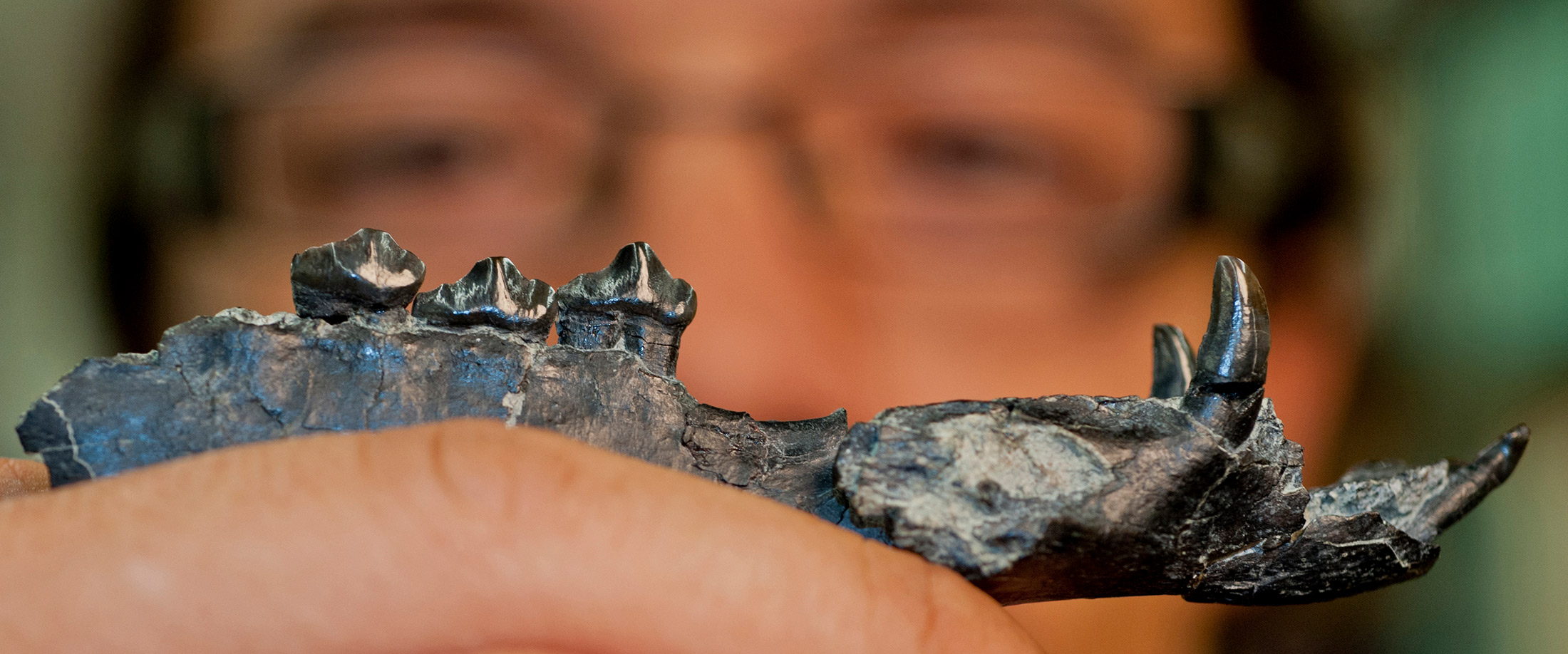
Florida Museum photo by Jeff Gage
When it comes to camels, it’s difficult not to think of the Old World depicted through Arabian Nights – Bedouin travelers crossing vast, radiant deserts by day, through dark, star-spotted Arabian nights. But according to the fossil record, the ancestors of modern camels were creatures of the New World.
Based on fossils from the North American Great Plains, the earliest-known camels dwelled in the American savannah about 35 million years ago. It was a time before the formation of the Isthmus of Panama, when the continents of North and South America were still separated by the oceanic waters. But despite the separation of the continents, recent Panama Canal excavations by Florida Museum of Natural History researchers show ancient camels similar to those in North America also thrived in Central America 20 million years ago.
“We’re discovering this fabulous new diversity of animals that lived in Central America that we didn’t even know about before,” said Florida Museum vertebrate paleontology curator Bruce MacFadden, co-principal investigator on the National Science Foundation grant funding the Panama Canal project. “Prior to this discovery, they (ancient camels) were unknown south of Mexico.”
In the first published description of a fossil mammal discovered since the project began in 2009, Florida Museum researchers identified two new species of ancient extinct camels that inhabited the area about 20 million years ago. The research extends the distribution of mammals to their southernmost point in the ancient tropics, some of the most diverse areas today about which little is known historically because lush vegetation prevents paleontological excavations. The study appeared online in the Journal of Vertebrate Paleontology Feb. 28, 2012.
“People think of camels as being in the Old World, but their distribution in the past is different than what we know today,” said MacFadden, a study co-author. “The ancestors of llamas originated in North America and then when the land bridge formed about 4 to 5 million years ago, they dispersed into South America and evolved into the llama, alpaca, guanaco and vicuña.”

Florida Museum photo by Jeff Gage
Based on analysis of partial jaws and teeth and comparisons with relatives from Florida, Texas and Mexico, researchers described two species of floridatragulines, ancient camels that are also the oldest mammals found in Central America: Aguascalientia panamaensis and Aguascalientia minuta. Distinguished from each other mainly by their size, the two ancient camels belong to an evolutionary branch of the camel family that may be separate from the one that gave rise to modern camels because of their complicated morphology, which includes different proportions of teeth and elongated jaws.
“Some descriptions say these are ‘crocodile-like’ camels because they have more elongated snouts than you would expect,” said lead author Aldo Rincon, a UF geology doctoral student. “They were probably browsers in the forests of the ancient tropics. We can say that because the crowns are really short.”
Rincon discovered the fossils in the Las Cascadas formation nearly single-handedly, unearthing pieces of a jaw belonging to the same animal over a span of two years, he said. Rincon then worked with his graduate adviser, associate curator of vertebrate paleontology and study co-author Jonathan Bloch, to assess the specimens and describe their morphology.
“When I came back to the museum, I started putting everything together and realized, ‘Oh wow, I have a nearly complete jaw,’ ” Rincon said. “This is one of the nicest specimens because it shows the interior dentition, which was previously unknown for this type of camel.”
The study shows that despite Central America’s close proximity to South America, there was no connection between continents because mammals in the area 20 million years ago all had North American origins. The Isthmus of Panama formed about 15 million years later and the fauna crossed to South America 2.5 to 3 million years ago, MacFadden said.

Florida Museum photo by Jeff Gage
Barry Albright, a professor of earth science at the University of North Florida who studied the early Miocene fauna of the Gulf Coast Plain, said he was surprised by the similarity of the Central American fauna.
“To me, it’s slightly unexpected,” Abright said. “That’s a large latitudinal gradient between the Gulf Coastal Plain and Panama, yet we’re seeing the same mammals, so perhaps that tells us something about climate over that interval of time and dispersal patterns of some mammals over that interval of time. “It’s interesting to see a fauna that far south really similar to a fauna in the Gulf Coastal Plain and even mammals up in the Great Plains.”
Camels belong to a group of even-toed ungulates that includes cattle, goats, sheep, deer, buffalo and pigs. Other fossil mammals discovered in Panama from the early Miocene have been restricted to those also found in North America at the time. While researchers are sure the ancient camels were herbivores that likely browsed in forests, they are still analyzing seeds and pollen to better understand the environment of the ancient tropics.
Discovery of the fossils was made possible through the NSF-funded Panama Canal Partnerships for International Research and Education project, which supports excavation of the Panama Canal during construction to widen and straighten the channel and build new locks. The construction is expected to continue through 2014. The $3.8 million-project supports development of partnerships between the U.S. and Panama and engagement of the next generation of scientists in paleontological and geological discoveries along the canal.
Study co-authors include Catalina Suarez and Carlos Jaramillo of the Smithsonian Tropical Research Institute.
Learn more about the Panama Canal Project Partnership for International Research and Education (PCP PIRE) at the Florida Museum.
Learn more about the Vertebrate Paleontology at the Florida Museum.